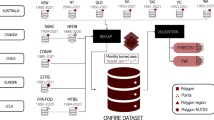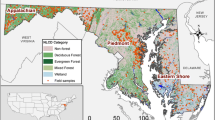Abstract
Biomass burning constitutes a major contribution to global emissions of carbon dioxide, carbon monoxide, methane, greenhouse gases and aerosols. Furthermore, biomass burning has an impact on health, transport, the environment and land use. Vegetation fires are certainly not recent phenomena and the impacts are not always negative. However, evidence suggests that fires are becoming more frequent and there is a large increase in the number of fires being set by humans for a variety of reasons. Knowledge of the interactions and feedbacks between biomass burning, climate and carbon cycling is needed to help the prediction of climate change scenarios. To obtain this knowledge, the scientific community requires, in the first instance, information on the spatial and temporal distribution of biomass burning at the global scale. This paper presents an inventory of burned areas at monthly time periods for the year 2000 at a resolution of 1 kilometer (km) and is available to the scientific community at no cost. The burned area products have been derived from a single source of satellite-derived images, the SPOT VEGETATION S1 1 km product, using algorithms developed and calibrated at regional scales by a network of partners. In this paper, estimates of burned area, number of burn scars and average size of the burn scar are described for each month of the year 2000. The information is reported at the country level. This paper makes a significant contribution to understanding the effect of biomass burning on atmospheric chemistry and the storage and cycling of carbon by constraining one of the main parameters used in the calculation of gas emissions.
Similar content being viewed by others
References
Andreae, M. O. and Merlet, P.: 2001, ‘Emission of trace gases and aerosols from biomass burning’, Global Biogeochem. Cycles 15, 955–966.
Barbosa, P. M., Grégoire, J.-M., and Pereira, J. M. C.: 1999a, ‘An algorithm for extracting burned areas from time series of AVHRR GAC data applied at a continental scale’, Remote Sensing Environ. 69, 253–263.
Barbosa, P. M., Stroppiana, D., Grégoire, J.-M., and Pereira, J. M. C.: 1999b, ‘An assessment of vegetation fire in Africa (1981–1991): Burned areas, burned biomass, and atmospheric emissions’, Global Biogeochem. Cycles 13, 933–950.
Boschetti, L., Flasse, S., Trigg, S., and de Dixmude, A. J.: 2002, ‘A multitemporal change detection algorithm for the monitoring of burnt areas with spot vegetation data’, in Bruzzone, L. and Smits, P. (eds.), Analysis of MultiTemporal Remote Sensing Images, World Scientific, Singapore, pp. 75–82.
Breiman, L., Friedman, J. H., Olshen, R. A., and Stone, C. J.: 1984, Classification and Regression Trees, Wadsworth & Brooks, California.
Brivio, P. A., Maggi, M., Binaghi, E., Gallo, I., and Grégoire, J.-M.: 2002, ‘Exploiting spatial and temporal information for extracting burned areas from time series of SPOT-VGT data’, in Bruzzone, L. and Smits, P. (eds.), Analysis of MultiTemporal Remote Sensing Images, World Scientific, Singapore, pp. 132–139.
Cahoon Jr., D. R., Stocks, B. J., Levine, J. S., Cofer III, W. R., and Pierson, J. M.: 1994, ‘Satellite Analysis of the Severe 1987 Forest Fires in northern China and southeastern Siberia’, J. Geophys. Res. 99, 627–638.
Colby, J. D.: 1991, ‘Topographic Normalization in Rugged Terrain’, Photogramm. Eng. Remote Sensing 57, 531–537.
Conard, S. G., Sukhinin, A. I., Stocks, B. J., Cahoon, D. R., Davidenko, E. P., and Ivanova, G. A.: 2002, ‘Determining effects of area burned and fire severity on carbon cycling and emissions in Siberia’, Climate Change 55, 197–211.
Dwyer, E., Pereira, J. M. C., Grégoire, J.-M., and DaCamara, C. C.: 1999, ‘Characterization of the spatio-temporal patterns of global fire activity using satellite imagery for the period April 1992 to March 1993’, J. Biogeogr. 27, 57–69.
Eastwood, J. A., Plummer, S. E., Wyatt, B. K., and Stocks, B. J.: 1998, ‘The potential of SPOT-vegetation data for fire scar detection in boreal forests’, Int. J. Remote Sensing 19, 3,681–3,687.
Ershov, D. V. and Novik, V. P.: 2001, ‘Mapping burned areas in Russia with SPOT4 VEGETATION (S1 Product) imagery’, Final Report for the Joint Research Centre of the European Commission, Contract Number: 18176-2001-07-F1EI ISP RU.
Eva, H. D., Malingreau, J. P., Grégoire, J.-M., Belward, A. S., and Mutlow, C. T.: 1998, ‘The advance of burnt areas in Central Africa as detected by ERS-1 ATSR-1’, Int. J. Remote Sensing 19, 1,635–1,637.
Fernández, A., Illera, P., and Casanova, J. L.: 1997, ‘Automatic mapping of surfaces affected by forest fires in Spain using AVHRR NDVI composite data’, Remote Sensing Environ. 60, 153–162.
Fraser, R. H., Fernandes, R., and Latifovic, R.: 2003, ‘Multi-temporal mapping of burned forest over Canada using satellite-based change metrics’, Geocarto Int. 18, 37–48.
Fraser, R. H., Li, Z., and Cihlar, J.: 2000, ‘Hotspot and NDVI differencing synergy (HANDS): A new technique for burned area mapping over boreal forest’, Remote Sensing Environ. 74, 362–376.
Grégoire, J.-M., Tansey, K., and Silva, J. M. N.: 2003, ‘The GBA, 2000 initiative: Developing a global burned area database from SPOT-VEGETATION imagery’, Int. J. Remote Sensing 24, 1,369–1,376.
Hansen, M. C., Defries, R. S., Townshend, J. R. G., and Sohlberg, R.: 2000, ‘Global land cover classification at 1 km spatial resolution using a classification tree approach’, Int. J. Remote Sensing 21, 1,331–1,364.
Hastings, D. A. and Dunbar, P. K.: 1998, ‘Development and assessment of the global land one-km base elevation digital elevation model (GLOBE)’, Int. Soc. Photogramm. Remote Sensing Arch. 32, 218–221.
Houghton, R. A.: 1991, ‘Biomass burning from the perspective of the global carbon cycle’, in Levine, J. S. (ed.), Global Biomass Burning: Atmospheric, Climatic, and Biospheric Implications, MIT Press, Cambridge, MA, pp. 321–325.
Isaev, A. S., Korovin, G. N., Bartalev, S. A., Ershov, D. V., Janetos, A., Kasischke, E. S., Shugart, H. H., French, N. H. F., Orlick, B. E., and Murphy, T. L.: 2002, ‘Using remote sensing to assess Russian forest fire carbon emissions’, Climate Change 55, 235–249.
Johnson, R. A. and Wichern, D.W.: 1988, Applied Multivariate Statistical Analysis (Second Edition), Prentice Hall, New Jersey.
Kasischke, E. S., Christensen, N. L., and Stock, B. J.: 1995, ‘Fire, global warming, and the carbon balance of boreal forests’, Ecol. Appl. 5, 437–451.
Kempeneers, P., Swinnen, E., and Fierens, F.: 2002, GLOBSCAR Final Report, TAP/N7904/FF/FR-001 Version 1.2, VITO, Belgium.
Levine, J. S.: 1996, ‘FireSat and the global monitoring of biomass burning’, in Levine, J. S. (ed.), Biomass Burning and Global Change, The MIT Press, Cambridge, MA, pp. 107–132.
Malingreau, J. P. and Grégoire, J.-M.: 1996, ‘Developing a global vegetation fire monitoring system for global change studies: A framework’, in Levine, J. S. (ed.), Biomass Burning and Global Change, The MIT Press, Cambridge, MA, pp. 14–24.
Page, S. E., Siegart, F., Rieley, J. O., Boehm, H.-D. V., Jaya, A., and Limin, S.: 2002, ‘The amount of carbon released from peat and forest fires in Indonesia during 1997’, Nature 420, 61–65.
Pereira, J. M. C.: 1999, ‘A comparative evaluation of NOAA/AVHRR vegetation indices for burned surface detection and mapping’, IEEE Trans. Geosci. Remote Sensing 37, 217–226.
Pereira, J. M. C., Mota, B. W., Privette, J. L., Caylor, K. K., Silva, J. M. N., Sá, A. C. L., and Ni-Meister, W.: in press, ‘A simulation analysis of the detectability of understory burns in Miombo Woodland’, Remote Sensing Environ.
Pereira, J. M. C., Pereira, B. S., Barbosa, P. M., Stroppiana, D., Vasconcelos, M. J. P., and Grégoire, J.-M.: 1999, ‘Satellite monitoring of fire in the EXPRESSO study area during the 1996 dry season experiment: Active fires, burnt area and atmospheric emissions’, J. Geophys. Res. 104, 30,701–30,712.
Roujean, J. L., Leroy, M., and Deschamps, P. Y.: 1992, ‘A bi-directional reflectance model of the earth’s surface for the correction of remotely sensed data’, J. Geophys. Res. 97, 20,455–20,468.
Roy, D., Lewis, P. E., and Justice, C. O.: 2002, ‘Burned area mapping using multi-temporal moderate spatial resolution data–-A bi-directional reflectance model-based expectation approach’, Remote Sensing Environ. 83, 263–286.
Scholes, R. J., Kendall, J., and Justice, C. O.: 1996, ‘The quantity of biomass burned in Southern Africa’, J. Geophys. Res. 101, 23,667–23,676.
Schultz, M. G.: 2002, ‘On the use of ATSR fire count data to estimate the seasonal and interannual variability of fire emissions’, Atmos. Chem. Phys. Discuss. 2, 1,159–1,179.
Siegart, F., Ruecker, G., Hinrichs, A., and Hoffmann, A. A.: 2001, ‘Increased damage from fires in logged forests during droughts caused by El Nino’, Nature 414, 437–440.
Silva, J. M. N., Pereira, J. M. C., Cabral, A. I., Sá, A. C. L., Vasconcelos, M. J. P., Mota, B., and Grégoire, J.-M.: 2003, ‘The area burned in Southern Africa during the 2000 dry season’, J. Geophys. Res. 108, D13, 8498, doi: 10.1029/2002JD002320.
Silva, J. M. N., Sousa, A. M. O., Pereira, J. M. C., Tansey, K., and Grégoire, J.-M.: 2002, ‘A Contribution for a Global Burned Area Map’, in Viegas, D. X. (ed.), Forest Fire Research & Wildland Fire Safety, Millpress, Rotterdam.
Stroppiana, D., Pinnock, S., Pereira, J. M. C., and Grégoire, J. M.: 2002, ‘Radiometric analysis of spot vegetation images for burnt area detection in Northern Australia’, Remote Sensing Environ. 82, 21–37.
Stroppiana, D., Tansey, K., Grégoire, J.-M., and Pereira, J. M. C.: 2003, ‘An algorithm for mapping burnt areas in Australia using SPOT-VEGETATION data’, IEEE Trans. Geosci. Remote Sensing 41, 907–909, doi: 10.1109/TGRS.2003.808898.
Tansey, K.: 2002, Implementation of the Regional Burnt Area Algorithms for the GBA, 2000 Initiative, Publication of the European Communities, EUR 20532 EN.
Tansey, K., Grégoire, J. M., Stroppiana, S., Sousa, A., Silva, J. M. N., Pereira, J. M. C., Boschetti, L., Maggi, M., Brivio, P. A., Fraser, R., Flasse, S., Ershov, D., Binaghi, E., Graetz, D., and Peduzzi, P.: 2004, ‘Vegetation burning in the year 2000: Global burned area estimates from SPOT VEGETATION data’, J. Geophys. Res. 109, D14503 doi: 10.1029/2003JD003598.
Trigg, S. and Flasse, S.: 2000, ‘Characterizing the spectral-temporal response of burned savannah using in situ spectroradiometry and infrared thermometry’, Int. J. Remote Sensing 21, 3,161–3,168.
Van Aardenne, J. A., Dentener, F. J., Olivier, J. G. J., Klein Goldewijk, C. G. M., and Lelieveld, J.: 2001, ‘A 1∘× 1∘ resolution data set of historical anthropogenic trace gas emissions for the period 1890–1990’, Global Biogeochem. Cycles 15, 909–928.
Van der Werf, G. R., Randerson, J. T., Collatz, G. J., Giglio, L., Kasibhatla, P. S., Avelino, A., Olsen, S. C., and Kasischke, E. S.: 2004, ‘Continental-scale partitioning of fire emissions during the 1997–2001 El Niño/La Niña period’, Science 303, 73–76.
Wotawa, G., Novelli, P. C., Trainer, M., and Granier, C.: 2001, ‘Inter-annual variability of summertime CO concentrations in the Northern Hemisphere explained by boreal forest fires in North America and Russia’, Geophys. Res. Lett. 28, 4,575–4,578.
Author information
Authors and Affiliations
Corresponding author
Rights and permissions
About this article
Cite this article
Tansey, K., GrÉgoire, JM., Binaghi, E. et al. A Global Inventory of Burned Areas at 1 Km Resolution for the Year 2000 Derived from Spot Vegetation Data. Climatic Change 67, 345–377 (2004). https://doi.org/10.1007/s10584-004-2800-3
Received:
Revised:
Issue Date:
DOI: https://doi.org/10.1007/s10584-004-2800-3




